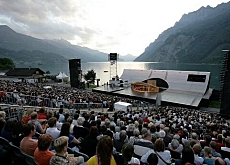Heidi looks back on a life less ordinary

One of Switzerland's best-loved exports, the little mountain girl Heidi, was a cult figure in her younger years but she disappeared from public life decades ago.
Johanna Spyri’s heart-warming story was based on the real-life adventures of Heidi Schwaller, 92, who grew up near Chur in the Swiss Alps. swissinfo tracked down Heidi to find out what became of the legend.
Fresh from the birthday party of one of her fellow residents in the luxurious retirement home of Ruhetal, Schwaller sips champagne in the garden while she reminisces about the glitterati of a former era.
“Bob Hope was such a charming and amusing gentleman, and he was very interested in Switzerland because his grandmother was Swiss. We stayed in touch for a long time.”
The former mountain girl has a large collection of photographs of herself with famous international personalities, including one of her in traditional costume with the Sultan of Brunei.
Schwaller had a special contract in the 1950s as court storyteller to the royal family of Brunei. “I used to go there for a fortnight every year to entertain the children; we communicated in French but I used to teach them funny phrases in Swiss German,” she laughs.
Elegant yet down-to-earth, Schwaller recalled how she met Spyri when the writer spent summers near the village of Maienfeld in eastern Switzerland more than 80 years ago.
Spyri was drawn to Heidi and her grandfather and took an interest in the child’s welfare. She even paid for Heidi’s schoolbooks one year when times were hard.
“What I remember most about Frau Spyri is her beautiful clothes. She was from Zurich, which was a world away from our lifestyle in the mountains. She often came to visit and have chats with my grandfather,” Schwaller recalls.
Household name
The Schwallers were happy to have a story written about them but they had no idea how much the book would change their lives. It wasn’t long before Heidi became a household name at home and abroad.
“Grosspapi, as I called him, tried his best to protect me from the public attention while I was still young, turning down requests from newspapers and so on.”
“But as soon as I was old enough, I myself sought out the celebrity. “Heidi” was a massive hit and suddenly all the doors of high society were open to me.”
Schwaller was advised to employ a manager, Jurg Boschung, and he organised for her to travel the world making guest appearances, enjoying the peak of her fame in the 1930s.
Although she had been engaged to her childhood companion Peter, she was persuaded by Boschung to break it off and instead improve her education. She later married the manager but the union did not last.
“I think a lot of things changed for me after the war. I took a step back during those years; I wanted to be in my home country and when peace came, what I wanted most was to settle down.”
Home to Peter
Luckily Peter had not given up on Heidi and the two finally did take their wedding vows in Maienfeld where they built a fine new house. The couple went on to have four children.
“We were happy in the early years because we had plenty of money and we were occupied with the children, but not needing to work gradually began to have a bad affect on Peter and he developed a drink problem.”
Although the couple never divorced, they did live apart for the last 20 years of their married life. Schwaller reverted to her maiden name after Peter’s death in 1981.
“I continued to take occasional jobs that interested me, like the work in Brunei, but mostly I dedicated myself to helping with the grandchildren and those were very enjoyable years.”
In more recent years Schwaller lent her name to charity work, particularly children’s charities, and she still attends fundraising dinners occasionally.
Schwaller enjoys close contact with her family, including her three great-grandchildren. She also likes to keep up with her fan mail and enjoys going for walks in the garden of Ruhetal.
swissinfo, Clare O’Dea in Ruhetal
[This article was originally published on April 1, 2008]
Heidi is by far the most popular work of Swiss literature.
It has been translated from German into 50 languages and been filmed more than a dozen times, including one Shirley Temple version (1937).
More than 50 million copies of Heidi books have been sold worldwide.
Johanna Spyri’s novel Heidi tells the story of an orphan girl who is taken by an aunt to live with her grandfather at the age of five. The heroine of the story, Heidi Schwaller, is now aged 92 and lives in central Switzerland.
In the book Heidi spends three years living with her grandfather in a humble chalet high in the Swiss Alps. Despite her grandfather’s gruff manner, the two form a close bond. Heidi also makes friends in the village, notably with Peter the goatherd.
One day her aunt appears again and takes Heidi away to be a live-in companion to Clara, the invalid daughter of a wealthy businessman in Frankfurt.
Heidi is out of place and increasingly unhappy in her new home. The housekeeper Frau Rottenmeier is hard on the Swiss girl and insists on calling Heidi by her full name Adelheid.
Despite her growing friendship with Clara, Heidi suffers badly from homesickness and she starts sleepwalking. Finally it is decided to send her back to her grandfather.
The two girls stay in touch and Clara comes to visit the Alps in the summer. Peter destroys her wheelchair out of jealousy but as a result of this Clara finds the strength to walk again.

In compliance with the JTI standards
More: SWI swissinfo.ch certified by the Journalism Trust Initiative










You can find an overview of ongoing debates with our journalists here . Please join us!
If you want to start a conversation about a topic raised in this article or want to report factual errors, email us at english@swissinfo.ch.